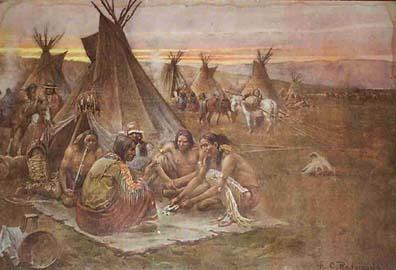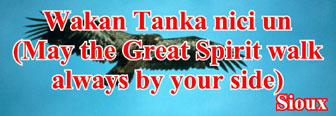




By



We were all surprised and pleased by the tribute paid to our country's Native Americans at the opening of the International Olympic Games in Utah. Everything was there, the drumming, dancing and feathered regalia...the romantic, warrior image, so familiar to us all.
This was a sporting event, yet not one word was said about the Indians love of the game...a side of him that somehow, is never portrayed.
Getting past the patented image, you will find a people quick to laugh, quick to enjoy competitive sports, quick to love winning, and quick to take losing in stride and try again. All the virtues of a true sportsman are there. How many Indian games are YOU familiar with?

Goal-scoring games were extremely popular. The balls used were made of sand or clay and covered with buckskin. Sticks and racquets were fashioned in ways suitable for the game being played. In fact, some Lacrosse teams of today are still using racquets very similar to those used by the Iroquois and Huron many years ago.
Shinny was another form of Lacrosse, the difference being in the teams. Most teams were mixed, having both men and women. The Crow, however, preferred all-men and all-woman teams playing against each other.
A different goal-scoring ball game was a women's game called Double-Ball (Obonistuts by the Cheyenne). A leather thong held two balls together. Using a kind of hockey stick, the thong was hooked and the double-ball slung into the air and over a raised horizontal pole at the opposing team's end of the field. Teams could be of any size, depending on who wanted to play.
Another game played only by women was Football. Unlike the game that is played today, no body contact was allowed. Much like Soccer, only kicking was used.

A winter sport called Snow Snake brought excited spectators and lots of wagering. A deep trough was made by pulling a log through the snow for some distance. A wooden staff, often carved to resemble a snake, was then thrown, and the distance measured. The longest throw won.
Hoop games enjoyed a lot of popularity. Both children and adults play them. A hoop was netted, the net being divided into the earth's four sections, north, south, east and west. The hoop was then rolled at a distance of about 100-150 feet from the player. Choosing a section on the hoop to hit, the playing would throw a dart to try and make a hit. Scoring was counted accordingly.
There were a number of ways to show ones skill with the bow and arrow. Targets of deer hide four feet square were hung from an eight-foot pole at a distance of fifty yards. The man who got the most arrows in the target was the winner.
If prowess really wanted to be tested, the target could always become twisted wisps of grass hung from a distant tree limb.

Foot Racing and later Horse Racing, were often intertribal and like Snow Snake drew a crowd of onlookers. Some horse races often included snatching a ring from a pole, with a lance, while riding at full gallop.
Sham Battles, within the tribe, pitted experienced warriors against untried youth. As in all games, honing one's skills was the underlying factor.
Only the Creeks and Seminoles played Single Pole Game. A cow's skull was placed atop a pole, the object being to knock it off with a ball. Women could use their hands in throwing, but men had to perform the feat using only two sticks, one in each hand.

Wrestling, much the same as today, only no use of outside objects. One big difference...for the Inuits, it was sometimes used to avenge a murder. Such a match ended in death to the loser.
Milder games included stilt walking and juggling, among the Hopi and Shoshone, and all tribes had tugs-of-war and push-of-war games.
Finally, no list of Indian games can be complete without mentioning the Song Fight. Contestants had to be able to remember the greatest number of songs, (every verse) and sing them all the way through. An option was to sing a new song, all the way through, after hearing it sung to you just one time.

 |
Be a sport. Try some of these games with your children or grandchildren. And while you are doing that, take time to tell them about Jim Thorpe, of Sac, Fox and Potawatoni ancestry who won the Pentathlon and Decathlon back in 1912, in the Olympic Games in Sweden. A Native American with two gold medals to his credit. Don't let him slip from our history. Grandmother Two Bears. |

This story and many mores stories are now available in the new book The Story Teller by Grandmother Two Bears. To order the Grandmother Two Bears book, use the following button.
| Order The Story Teller |





| Previous | Sky Voices | Next |
| Navigation & Site Map | What's New & Updated |